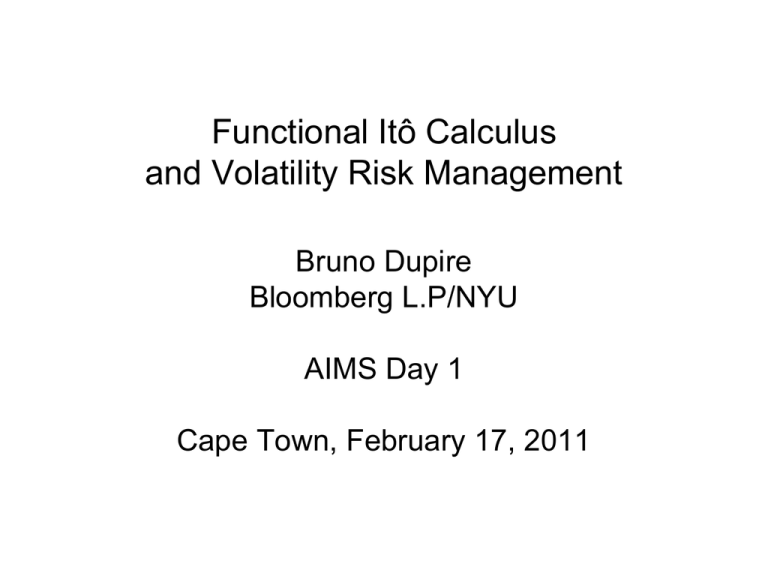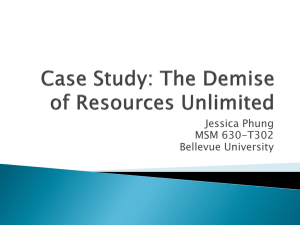Bruno Dupire Slide 2
advertisement

Functional Itô Calculus
and Volatility Risk Management
Bruno Dupire
Bloomberg L.P/NYU
AIMS Day 1
Cape Town, February 17, 2011
Outline
1)
Functional Itô Calculus
•
•
•
Functional Itô formula
Functional Feynman-Kac
PDE for path dependent options
2)
Volatility Hedge
•
•
•
•
•
Local Volatility Model
Volatility expansion
Vega decomposition
Robust hedge with Vanillas
Examples
1) Functional Itô Calculus
Why?
Most oft en,t heimpactof uncert ainty is cumulat ive. T helink
Cause Consequence
f
Xt
yt f ( X t )
depends on cert ainpat t erns:
t emperat ure wat er level
price hist ory pat hdependentpayoff
exposuret o ant igen viralreact ion
int erestrat epat h MBS prepayment
It ôcalculus deals wit h funct ionsof processes.
W e ext endit t ofunct ionsof t hecurrent pat h,
or hist ory,of t heprocess.
Review of Itô Calculus
• 1D
• nD
• infiniteD
• Malliavin Calculus
• Functional Itô Calculus
current value
possible evolutions
Functionals of running paths
Functionals defined not only on thewhole path[0,T ]but on all startingsections[0,t]
t {RCLL functions[0,t] }
t
t[ 0 ,T ]
f functional: f : , for X t t , f ( X t )
T he value of X t at s t is X t ( s ) and xt X t (t )
12.87
6.34
6.32
0
T
Examples of Functionals
- Current average
- Current drawdown
- Conditional expectation of final value
- Super - replicating price
T helast one coverstheimportantcase of pathdependentoptionprice
Finitenumber of state variables(excluding time):
- European(1)
- Asian (2)
- Optionon range (3)
Infinitenumber of state variables
- Max of rollingaverage
- First timelast valueis hit
Derivatives
t {RCLL functions[0,t ] },
t
t[ 0 ,T ]
For X t t , f : ,
X th ( s ) X t ( s ) for s t X th (t ) X t (t ) h
X t ,t ( s ) X t ( s ) for s t X t ,t ( s ) X t (t ) for s [t , t t ]
Space derivative
f ( X th ) f ( X t )
x f ( X t ) lim
h 0
h
T imederivative
f ( X t ,t ) f ( X t )
t f ( X t ) lim
t 0
t
Examples
f
xt
x f
t f
1
0
t
0
xu du
0
xt
h
f
x
x
If f ( X t ) h( xt , t ), then
f h
t
t
QVt
2 ( xt xt )
0
Topology and Continuity
- distance:
For all X t , Ys in , (we can assume t s)
d ( X t , Ys ) X t , s t Ys
Y
t
s t
s
X
- cont inuity:
A funct ionalf : is cont inuousat X t if :
0, 0 : Ys ,
d ( X t , Ys ) f (Ys ) f ( X t )
Functional Itô Formula
Definit ion: a functionalf : is sm oothif it is - continuous,
C 2 in x and C 1 in t , wit h these derivatives themselves - continuous.
T heorem
If x is a continuoussemi - martingaleand X t denotesits pathover[0,t],
then,for all smoothfunctionalf and for all T 0 ,
T
T
0
0
f ( X T ) f ( X 0 ) x f ( X t ) dxt
1 T
t f ( X t ) dt xx f ( X t ) d x
2 0
or, in moreconcisenotation,
1
df x f dx t f dt xx f d x
2
t
Fragment of proof
df f ( ) f ( )
( f ( ) f ( ))
( f (
( f (
) f (
) f (
))
))
Functional Feynman-Kac Formula
Generalisat ion of FK t onon Markovdynamicsand pat hdependentpayoff.
dxt a ( X t ) dt b( X t ) dWt
For g suit ably int egrable, g : T , r : . We define f : by
T
f (Yt ) E[e t
r ( Z u ) du
g ( Z T ) | Z t Yt ]
for u [0, t ], Z T (u ) Yt (u )
where
for u [t , T ], dzu a ( Z u ) du b( Z u ) dWu
T hen,if f is smoot h,it sat isfies
b2 ( X t )
t f ( X t ) a( X t ) x f ( X t ) r ( X t ) f ( X t )
xx f ( X t ) 0
2
t
(applyfunct ionalIt ôformula t o t hemart ingale e 0
r ( X u ) du
f ( X t ))
Delta Hedge/Clark-Ocone
If f defined by f (Yt ) E[ g ( Z T ) | Z t Yt ] is smoot h,
t hen wehave t heexplicitMart ingaleRepresent at ion:
T
g ( X T ) E[ g ( X T ) | X 0 ] b( X t ) x f ( X t ) dWt
0
From funct ionalIt ôand Feynman- Kac wit h r 0,
df ( X t ) b( X t ) x f ( X t ) dWt
and
T
g ( X T ) f ( X T ) f ( X 0 ) b( X t ) x f ( X t ) dWt
0
It can be comparedt o t heClark - Oconeformula
from MalliavinCalculus :
T
g ( X T ) E[ g ( X T ) | X 0 ] b( X t ) E[ Dt g ( X T ) | X t ] dWt
0
P&L of a delta hedged Vanilla
Option Value
P&L
Break-even
points
Delta
hedge
t
Ct t
Ct
t
St
S
St
St t
Functional PDE for Exotics
T
If f given by f (Yt ) E[e t
r ( Z u ) du
g ( Z T ) | Z t Yt ] is smooth,
thenit satisfies
1 2
t f ( X t ) b xx f ( X t ) r ( X t ) ( x f ( X t ) xt f ( X t )) 0
2
T he Γ/ trade- off for Europeanoptionsalso holds for path
dependentoptions,even withan infinitenumber of st at evariables.
However,in general Γ and will be pathdependent.
Classical PDE for Asian
T
P ayoffof Asian Call : g ( X T ) ( xu du K )
0
t
Assume dxt b( xt , t ) dWt Define I t xu du , f ( X t ) l ( xt , I t , t )
0
l l
t I xt t f x
I t
l
2l
x I 0 x f , xx f 2
x
x
1 2
l
l 1 2 2l
t f b xx f 0 x b
0
2
2
t
I 2 x
l
x is a botheringconvectionterm.
I
Better Asian PDE
T
t
0
0
Define J t Et [ xu du] xu du (T t ) xt , f ( X t ) h( xt , J t , t )
h
t J 0 t f
t
h
h
f
(
T
t
)
x
x
J
x J (T t )
2
2
2
h
h
h
2
f
2 (T t )
(T t )
2
xx
x
xJ
J 2
2
1 2
h 1 2 2 h
2h
h
t f b xx f 0 b ( 2 2 (T t )
(T t ) 2 2 ) 0
2
t 2
x
xJ
J
2) Robust Volatility Hedge
Local Volatility Model
• Simplest model to fit a full surface
• Forward volatilities that can be locked
dS
(r q) dt ( S , t ) dW
S
C 2 K , T 2 2C
C
K
r
q
K
q C
2
T
2
K
K
Summary of LVM
• Simplest model that fits vanillas
• In Europe, second most used model (after BlackScholes) in Equity Derivatives
• Local volatilities: fwd vols that can be locked by a
vanilla PF
2
2
• Stoch vol model calibrated E[ t St S ] loc ( S , t )
• If no jumps, deterministic implied vols => LVM
S&P500 implied and local vols
S&P 500 Fit
Cumulative variance as a function of strike. One curve per maturity.
Dotted line: Heston, Red line: Heston + residuals, bubbles: market
RMS in bps
BS: 305
Heston: 47
H+residuals: 7
Hedge within/outside LVM
• 1 Brownian driver => complete model
• Within the model, perfect replication by Delta
hedge
• Hedge outside of (or against) the model: hedge
against volatility perturbations
• Leads to a decomposition of Vega across strikes
and maturities
Implied and Local Volatility Bumps
P&L from Delta hedging
Assume r q 0, dxt v0 ( xt , t ) dWt .
For g T , define f by f ( X t ) E
Qv0
[g( XT ) X t ]
1
By functionalP DE, t f ( X t ) v0 ( xt , t ) xx f ( X t ) 0
2
If y follows dyt vt dWt with y0 x0 , by thefunctionalItôformula,
1 T
g (YT ) f (YT ) f (Y0 ) x f (Yt ) dyt t f (Yt ) dt vt xx f (Yt ) dt
0
0
2 0
T
1 T
f ( X 0 ) x f (Yt ) dyt (vt v0 ( yt , t )) xx f (Yt ) dt
0
2 0
T
T
Model Impact
Recall
g(YT ) f (YT ) f (X 0 )
T
0
x f (Yt ) dyt
1
2
T
0
(v t v 0 (y t ,t)) xx f (Yt ) dt
v,
Hence, with g (v) E Qv [g(YT ) X 0 ] and v (x,t) t he transition density for
1 Qv T
E [ (v t v 0 (x t ,t)) xx f (X t ) dt]
0
2
1 T
g (v 0 ) v (x,t) E Qv [(v t v 0 (x,t)) xx f (X t ) x t x]dx dt
2 0
g (v) g (v 0 )
Comparing calibrated models
Recall
1 T
g (v) g (v0 ) v ( x, t ) E Qv [(vt v0 ( x, t )) xx f ( X t ) xt x] dx dt
2 0
For a knock- out Barrier opt ion,
1 T
Qv
v
(
x
,
t
)
E
[(vt v0 ( x, t )) xx f ( X t ) xt x] dx dt
0
2
1 T
v ( x, t ) Palive ( x, t ) E Qv [(vt v0 ( x, t )) xx f ( X t ) xt x, alive] dx dt
2 0
2 f alive ( x, t ) Qv
1 T
v
alive ( x, t )
E [(vt v0 ( x, t )) xt x, alive] dx dt
2 0
x 2
If v and v0 are calibrat edon t hesame vanillaopt ions,E Qv [vt xt x] v0 ( x, t )
g (v) g (v0 )
It amount st o evaluat et heimpactof condit ioning by " alive":
E Qv [vt xt x, alive] E Qv [vt xt x]
Volatility Expansion in LVM
In general,
1 T
Qv
v
(
x
,
t
)
E
[(vt v0 ( x, t )) xx f ( X t ) xt x] dx dt
0
2
In thecase where v is a LVM of theformv0 u : dxt v0 ( xt , t ) u ( xt , t ) dWt
g (v) g (v0 )
1 T
Q
g (v0 u ) g (v0 ) v0 u ( x, t ) u ( x, t ) E v0 u [ xx f ( X t ) xt x] dx dt
2 0
g (v0 )
T
0
m( x, t ) u ( x, t ) dx dt
1 v0 u
Q
where m( x, t ) ( x, t ) E v0 u [ xx f ( X t ) xt x]
2
Fréchet Derivative in LVM
In particular,
g (v0 u ) g (v0 )
T
2
0
v u ( x, t ) u ( x, t ) E
0
Qv0 u
[ xx f ( X t ) xt x] dx dt
T heFréchetderivativein thedirectionof u satisfies:
g (v0 u ) g (v0 )
v g , u lim
0
1 T
Qv0
v0
(
x
,
t
)
u
(
x
,
t
)
E
[ xx f ( X t ) xt x] dx dt
0
2
T
0
m( x, t ) u ( x, t ) dx dt
where
1
Q
m( x, t ) v0 ( x, t ) E v0 [ xx f ( X t ) xt x]
2
is thesensitivity of g to thelocal varianceat ( x, t ) (Fréchetderivative)
One Touch Option - Price
Black-Scholes model S0=100, H=110, σ=0.25, T=0.25
One Touch Option - Γ
1
O.T . : m( S , t ) . .P
2
Up-Out Call - Price
Black-Scholes model S0=100, H=110, K=90, σ=0.25, T=0.25
Up-Out Call - Γ
1
UOC : m( S , t ) . .P
2
Black-Scholes/LVM comparison
In thiscase, no volatility input of theBlack - Scholes enables to reach theLVM price.
Vanilla hedging portfolio I
1
Q
Recall m( x, t ) v0 ( x, t ) E v0 [ xx f ( X t ) xt x] is thesensitivity of g
2
to thelocal varianceat (x,t).
P ortfolioPF ( K , T ) C K ,T dK dT of vanillashedges all small
volatilitymovesif and onlyif for all (x,t)
2 PF ( x, t )
Qv0
Qv0
E
[
(
X
)
x
x
]
E
[ xx f ( X t ) xt x] h( x, t )
xx
PF
t
t
2
x
How can we get thefunction ( K , T )?
Vanilla hedging portfolios II
k 1 2 v0 k
a) For k ( x, t ), we define L(k )
t 2 x 2
2C K ,T
2C K ,T
For a call C K ,T , L(
) 0 wit h boundary condition
( x, T ) K ( x )
x 2
x 2
2 PF
b) PF ( K , T ) C K ,T dK dT L(
)(x, t ) ( x, t )
x 2
2 PF
2 PF
Qv0
Q
k ( x, t ) E [ xx f ( X t )
( x, t ) xt x] h( x, t )
( x, t ) wit h h( x, t ) E v0 [ xx f ( X t ) xt x]
2
2
x
x
T hus, L(k ) L(h) .
h 1 2 v0 h
c) If we take L(h)
then L(k ) 0 wit h k(x,T) 0 k 0
t 2 x 2
2 PF
x, t , E [ xx f ( X t )
( x, t ) xt x] 0 and f - PF has no sensitivity tolocal volbumps
x 2
henceno sensitivity toimplied volbumps.
Qv0
Example : Asian option
T
dxt v 0 dWt P ay- off : g ( X t ) xt dt K , S0 K 100 volatility v0 20 maturityT 1
0
1
Q
m( x, t ) v0 ( x, t ) E v0 [ xx f ( X t ) xt x] is thesensitivity of g to thelocal varianceat (x,t).
2
T
T
K
K
Asian Option Hedge
Robust volatilityhedge with PF ( K , T ) CK ,T dK dT
h( K , T ) 1 2 v0 ( K , T )h( K , T )
( K , T )
2
t
2
x
T
T
K
K
Forward Parabola - Γ
Payoff:
g( XT ) (ST2 ST1 )2
T1 = 1, T2 = 2, S0 = 100, σ = 10
Forward Parabola Hedge
Forward Cube - Γ
Payoff:
g( XT ) (ST2 ST1 )3
T1 = 1, T2 = 2, S0 = 100, σ = 10
Forward Cube Hedge
Forward Start - Γ
Payoff
g( XT ) (ST2 ST1 )
T1 = 1, T2 = 2, S0 = 100, σ = 10
Forward Start Hedge
One Touch - Γ
Payoff
g ( X T ) 1{maxST H 104}
T1 = 1, H = 104 ,S0 = 100, σ = 5
One Touch Hedge
Link Γ/Vega
Robustness
• Superbucket hedge protects today from first order moves
in implied volatilities; what about robustness in the
future?
• After delta hedge, the tracking error is
1
TE
2
T
0
(v t v 0 (y t ,t)) xx f (Yt ) dt
• In the case of discrete hedging in the model or fast mean
reversion of vol, variance of TE is proportional to
E[ 0 ( xx f (Yt )) dt]
T
2
T
0
E[( xx f (Yt ))2 y t y] (y,t)dydt
Hedgeability
• The optimal vanilla hedge PF minimizes
T
E[( xx f (Yt ) xx PF(y,t))2 y t y] (y,t) dy dt
0
and thus coincides with the superbucket hedge as
xx PF(y,t) E[ xx f (Yt ) y t y]
• The residual risk is
T
0
Var[ xx f (Yt )) y t y] (y,t) dy dt
• The hedgeability of an option is linked to the dependency
of the functional gamma on the path
The Geometry of Hedging
Bruno Dupire
53
• In practice, determining the best hedge is not sufficient
Need to measure of residual risk
M
o
hedging
easure
f performan
e
2
H
2
H
X X
X
remaining
risk
after
hedging
H
1
2
1
2
initial
risk
before
hedging
X
X
2
2
Y
H
for
0
2
and
1
1
:
X
X
2
If
and
1
:H
0
.
X
Y
2
Y
If
1
or
0
:H
1
.
X
&
Y
highly
correlated
,
Basket
options
hedgeable.
with
similar
latility
Spread
vo
options
not
hedgeable.
H-Squared Parabola vs Cube
Skewness Products
• Negative Skewness: fat tail to the left
• Linked to UP Dispersion < Down Dispersion
i
n
/2 j
1n/2S
S
T
T
U
Dispersion
p
i
j
n
/2
S
i
1S
j
1
0
0
i
j
n
1 n S
S
T
T
Down
Dispersion
i
j
n
/2
S
i
n
/2
1S
j
n
/
2
1
0
0
Some products are based on
Up Dispersion – Down Dispersion
Hedge with Components
• Decorrelated Case
• Good hedge with risk reversals on the
components
Hedge with Components
• Correlated Case
• No hedge with components
BMW
Sample Mean of Best third
+
Sample Mean of Worst third
-2 x
Sample Mean of Middle third
Perfect Hedge for BMW, Correlation = 0%
Short 6 Shares, Short 9 Puts at –K*, Long 9 Calls at K*
Component Hedge
6
Norm Cdf = 2/3
4
Payoff
2
0
-2
Norm Cdf = 1/3
-4
-6
-3
-2
-1
0
Level
K* = 0.4307
1
2
3
BMW with 30 stocks , Correlation = 0
Hedge with Puts and Calls using 120 strikes
R-squared = 80.7%, MC runs = 10,000
1.5
Target
1
0.5
0
-0.5
-1
-1.5
-1
-0.5
Hedge
0
0.5
1
BMW with 30 stocks , Correlation = 40%
Hedge with Puts and Calls using 120 skrikes
R-squared = 5.8%, MC runs = 10,000
1
0.8
0.6
Target
0.4
0.2
0
-0.2
-0.4
-0.6
-0.8
-0.4
-0.3
-0.2
-0.1
0
Hedge
0.1
0.2
0.3
Analysis
• Correlation shifts the returns, which affects the
components hedge but not the target
• In the absence of hedge, it is a mistake to price the
product with a calibrated model
• Implied individual skewness is irrelevant !
• It is a wrong way to play implied versus realized
skewness
Conclusion
• Itô calculus can be extended to functionals of price paths
• Price difference between 2 models can be computed
• We get a variational calculus on volatility surfaces
• It leads to a strike/maturity decomposition of the volatility
risk of the full portfolio









